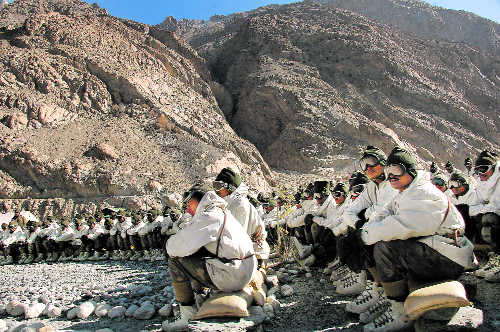
Soldiers are given acclimatization training at the base camp for about 15 days. A soldier’s stay can stretch up to four-five months. File photos
Shaurya Karanbir Gurung in New Delhi
Empty jam bottles are great: Fill 'em up with kerosene, drill a hole for the wick and light it. That’s what they — 10 in all — did at a post located at 19,600 feet on icy barren Siachen Glacier. Those were the darkest nights and sunless days.
That’s how Akshay Singh (name changed on request) had his first day at the glacier. He was a young lieutenant with only six months of service in 2003. He got there after acclimatizing at 6,000 feet, 9,000 feet and 12,000 feet. He had to learn, and learn fast, in about 15 days how to cope with deadly ice at altitudes where even moving one’s limbs can cause breathlessness. There are several things that work against you simultaneously: Your own weight, a blinding white wilderness, gravitational pull and a load of clothes, bedroll, ration, weapon and the climbing rope. Fear is a constant companion, occasionally overcome by the desire to survive.
Akshay remembered all the points in the rule book drilled into his head at Siachen Battle School, like: If left alone, what he will do, how he’d survive an avalanche, and most importantly, how he’d have nothing but himself to depend on.
The first night was as if a black cloud had engulfed his post. “There was snow and darkness everywhere. The power generator lay at the headquarters, thousands of feet below. And that was meant for the equipment,” he recalls.
“The jam bottles did the trick for the next four months,” he said. Then began the routine at 22,000 feet where temperatures at times drops to minus 50 degree Celsius. The task was cut out: Be alert 24x7, keep watch over the frontiers, ensure patrolling, maintain routes, clear snow, cook, and secure the Actual Ground Position Line (AGPL).
Akshay’s post was on an area of about 100 metres. For his solace was a separate accommodation, he being an officer: a Fibre Reinforced Plastic (FRP) tent. Inside, there is no bed, no furniture, no posters and no family pictures. There is a bedroll, which he had carried to the post and a pillow made of a plastic sandbag filled with food wrappers to make it “fluffy”.
“The first two nights I could not sleep. I had never been in this kind of atmosphere. My FRP was on a crevice (cracks in the ice). The crevice shifts in and out and at night I could hear it cracking,” he recalled.
The other area of the post consisted of the men’s barrack, two toilets and a kitchen which was open from one side. “Fire hazard prevented us from cooking our food inside the tent or the barrack. We seldom felt hungry even though we had special ration such as chocolates and chicken nuggets. The drinking water came from the melting ice,” he said.
Going to the kitchen also means chances of falling sick. When a man falls sick, he is a huge burden because he has to be taken on a stretcher to the nearest post with a helipad by four men 3,000 feet below. “Walking there is like tying weights to your feet and then pushing ahead. Out of the four rescuers, at least two fall sick because of exposure. Similarly, if one falls into a crevice, saving him is like rescuing a drowning man with weights attached to your body,” he said.
When he was there, Pakistani side would often fire artillery guns and other weapons at his location. “We hardly used the bathroom because it had a bullet-riddled door,” he says.
Right below this post at 18,500 feet was Bhagwan Singh (name changed on request) with about 28 other men. He recalled that attending the call of nature was done in the open or through a wooden board shaped as a toilet and placed among rocks. Before leaving with a group of other soldiers to a “half-link”, he remembers how OP Baba’s blessings were evoked. A half link is located between two posts. The men from a post at a lower altitude place the rations for the higher post here, because covering the entire distance is very difficult.
“We would report to our commander before leaving. And the commander would turn his back to us, stand in attention and say aloud: “itne bande gaye hain” (these many men left). While returning, he would repeat the same drill and say “itne bande wapis aa gaye” (these many men have returned). Everyone believed in OP Baba. He is our protector,” said Bhagwan.
Akshay recalls the no non-vegetarian days in respect for Baba. “He was in the artillery regiment and posted at the glacier. No one knows how he died. But he is known as the Guardian of the Glacier. Sometimes, he’d come in a soldier’s dreams to warn him of a disaster. Some say during their duty if they dozed off, they’d be slapped and when they awoke they would find none,” says Akshay.
Akshay and his men had their own “look out man” at their post, a dog named Moti. “He was brought there as a pup. And he never slept inside the tents. He could not bark, but only whimper, and he did when the men went to the half-link. He would stop yapping when they returned,” he says.
Almost four months later, Akshay and his men returned to the base camp at 12,000 feet, as per their rotation. “I had not shaved and bathed for four months. And when I returned I took a bath for one-and-a-half hours. When I shaved I got blisters, but it felt good. The unit had made continental food for us. We began eating at 8.30pm and finished at 11pm!” he says.



























